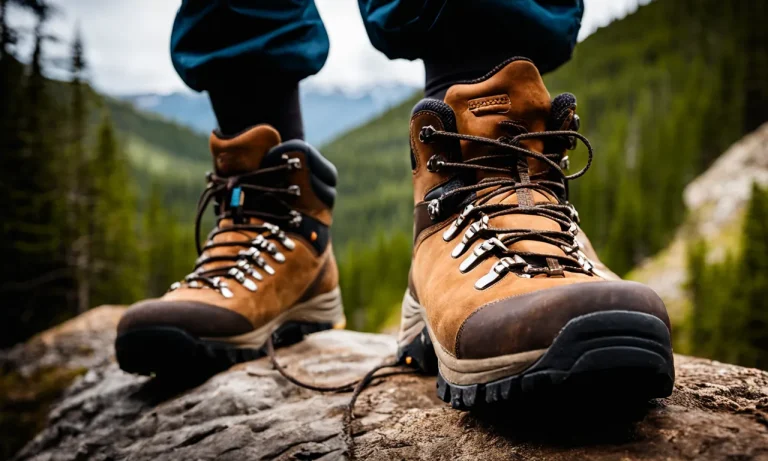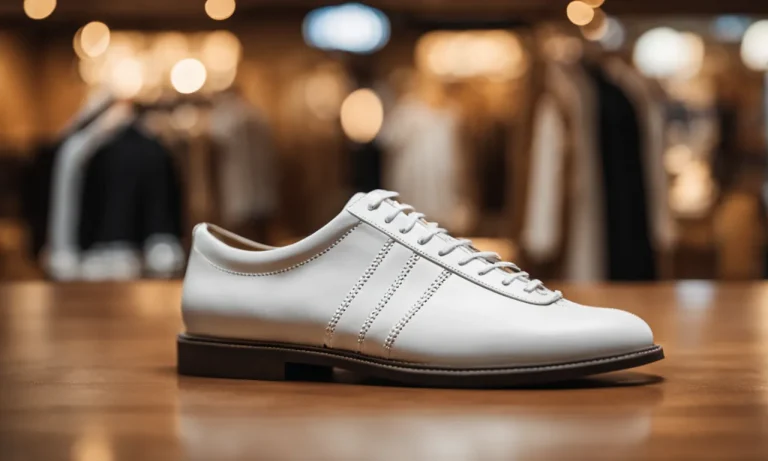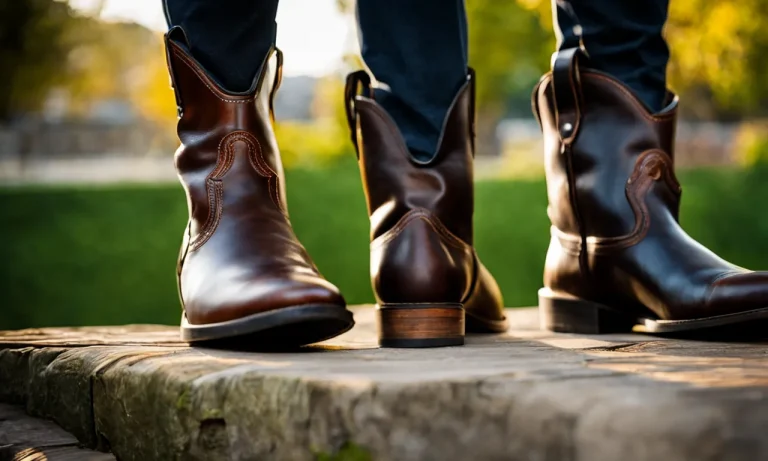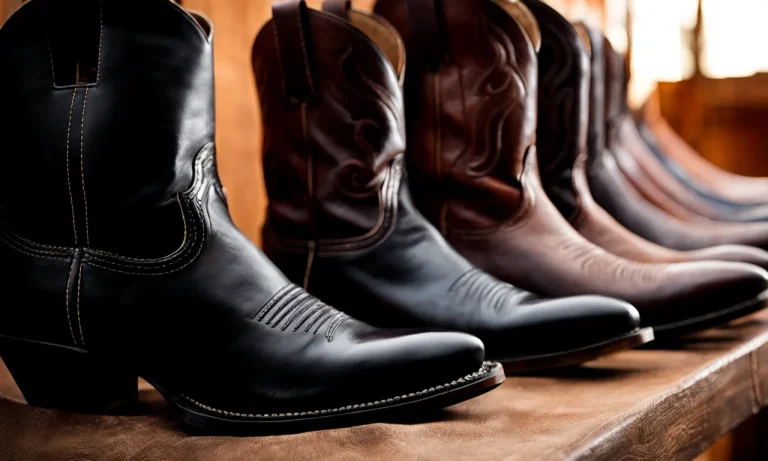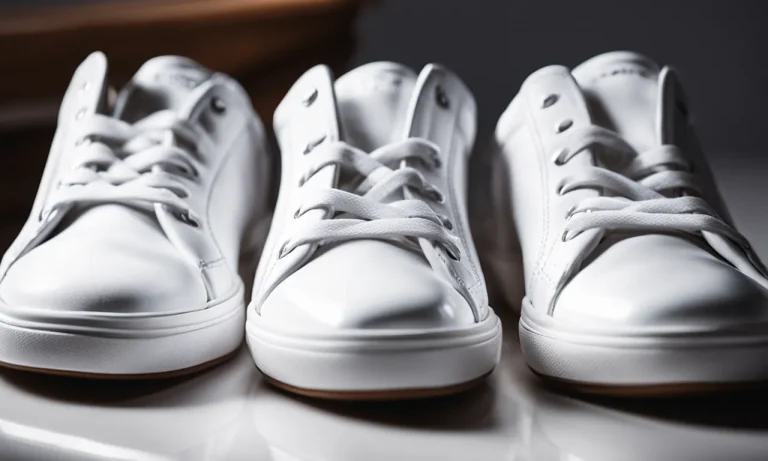Shoe shopping can be frustrating when you have wide feet. Should you size up in a regular width or buy shoes made specifically for wide feet? In this comprehensive guide, we’ll walk you through everything you need to know to find the perfect shoe for your wide feet.
If you’re short on time, here’s a quick answer to your question: Wearing properly fitted wide width shoes will provide the most comfort and support for those with wide feet. Size up in regular shoes only if wide sizes are unavailable.
We’ll cover how to measure your feet, differences between wide and regular sizes, pros and cons of each type of shoe, brands that offer wide widths, and tips for getting the perfect fit.
How to Measure Your Feet Properly
Using a Brannock Device
One of the most accurate ways to measure your feet is by using a Brannock Device. This tool, commonly found in shoe stores, measures the length and width of your feet. Simply place your foot on the device and adjust the sliders until they touch the edges of your foot.
The device will provide you with measurements in both inches and shoe sizes. This method ensures that you get the most accurate measurements for your feet.
Measuring at Home
If you don’t have access to a Brannock Device, you can still measure your feet at home. All you need is a ruler or tape measure and a flat surface. Place your heel against a wall and measure the distance from the wall to the longest toe on your foot.
Repeat this process for both feet and take note of the measurements. It’s important to measure both feet as they may have slightly different sizes. Use the larger measurement when determining your shoe size.
Considerations for High Arches or Flat Feet
When measuring your feet, it’s important to consider any specific foot conditions, such as high arches or flat feet. These conditions can affect the fit of your shoes and may require special considerations.
For example, individuals with high arches may need shoes with extra arch support, while those with flat feet may require shoes with more cushioning. If you have any foot conditions, it’s recommended to consult with a podiatrist or shoe specialist to ensure you find the right shoe size and style for your needs.
For more information on measuring your feet and finding the right shoe size, you can visit www.footwearetc.com or www.apma.org.
The Difference Between Wide and Regular Shoes
When it comes to finding the perfect pair of shoes, one size definitely does not fit all. Many people struggle with finding shoes that provide a comfortable and secure fit. This is where the difference between wide and regular shoes comes into play.
Understanding the distinction between these two types of shoes can help you make an informed decision about which option is best for you.
What Makes a Shoe Wide
A wide shoe, as the name suggests, is designed to accommodate individuals with wider feet. It offers more room in the toe box area, allowing the toes to spread out naturally. Wide shoes are typically marked with the letter “W” after the size number.
The width of a shoe is determined by measuring the circumference of the ball of the foot. If you find that regular shoes feel too tight or constricting, it may be worth considering a wide shoe to provide extra comfort and space.
Wide vs Regular Width Sizing
Wide and regular shoes differ not only in terms of width but also in their sizing. Wide shoes come in a variety of sizes, just like regular shoes. However, the width of a wide shoe is wider than that of a regular shoe.
For example, a regular women’s shoe might have a width of B, while a wide women’s shoe might have a width of D. It’s important to note that wide shoes may not be available in all styles and brands, so it’s essential to check the availability of wide options when shopping for shoes.
Other Factors that Impact Fit
While width is a crucial factor in determining the right shoe fit, there are other considerations to keep in mind. The shape of the shoe, arch support, and overall design can all affect how a shoe feels on your feet.
It’s important to try on shoes and walk around in them to assess their comfort level. Additionally, different brands may have slightly different sizing standards, so it’s always a good idea to consult the specific brand’s size chart to ensure the best fit.
When it comes to choosing between wide and regular shoes, it ultimately boils down to personal preference and comfort. If you frequently experience discomfort or tightness in regular shoes, trying out a wide shoe could be a game-changer.
Remember, the goal is to find a shoe that fits well and provides the necessary support for your feet.
Pros and Cons of Wide Width Shoes
Benefits of Wearing Wide Shoes
Wearing wide width shoes can offer several benefits for individuals who have wider feet or specific foot conditions. Here are some advantages:
- Improved Comfort: Wide shoes provide extra room for the toes to spread out, reducing pressure on the feet and allowing for a more comfortable fit. This can be especially beneficial for individuals with bunions, hammertoes, or other foot conditions.
- Reduced Foot Pain: By accommodating the natural shape of the foot, wide shoes can help alleviate foot pain caused by cramped spaces and pressure points. They can provide relief for conditions such as plantar fasciitis or arthritis.
- Better Stability: Wide shoes offer a wider base of support, which can enhance stability and balance. This can be particularly important for individuals who require extra support due to conditions like flat feet or pronation.
- Prevention of Foot Problems: Wearing wide shoes can help prevent the development of foot problems such as ingrown toenails, corns, and calluses. The additional space can reduce friction and pressure on the feet, promoting healthy foot conditions.
For more information on foot health and the benefits of wearing wide shoes, you can visit reputable websites like apma.org or foothealthfacts.org.
Downsides of Wide Width Shoes
While wide width shoes offer numerous advantages, there are a few downsides to consider:
- Limited Style Choices: Wide width shoes may have a more limited variety of styles and designs compared to regular width shoes. This can make it more challenging to find trendy or fashion-forward options.
- Potential Fit Issues: Some individuals with wider feet may find that wide width shoes still don’t provide the perfect fit. Different brands and shoe models may have varying definitions of “wide,” so it’s important to try on different pairs to find the best fit.
- Increased Cost: Wide width shoes may be slightly more expensive than regular width shoes due to the additional materials required to accommodate the wider foot. However, the cost difference is usually minimal.
Ultimately, the decision to wear wide width shoes versus regular shoes depends on individual preference, foot shape, and specific foot conditions. It’s always recommended to consult with a podiatrist or footwear specialist for personalized advice.
Pros and Cons of Sizing Up in Regular Shoes
Benefits of Sizing Up
When it comes to choosing between wide shoes and regular shoes, some individuals may find that sizing up in regular shoes can offer certain benefits. Here are some advantages:
- Improved Comfort: Sizing up in regular shoes can provide extra room for individuals with wider feet, reducing discomfort and allowing for better mobility.
- More Options: Regular shoes are more widely available in various styles, colors, and designs compared to wide shoes. By sizing up, individuals can have a wider range of choices, ensuring they find a shoe that suits their personal style.
- Cost Savings: Wide shoes are often more expensive than regular shoes. By sizing up, individuals with wider feet can avoid the higher price tag associated with wide shoes and save some money.
Drawbacks of Sizing Up in Regular Shoes
While there are benefits to sizing up in regular shoes, there are also some drawbacks to consider:
- Fit: Sizing up in regular shoes may lead to a less precise fit compared to wide shoes. This can result in shoes that are too loose or too tight in certain areas, potentially causing discomfort and foot-related issues.
- Limited Support: Wide shoes are specifically designed to provide extra support and stability for wider feet. By opting for regular shoes and sizing up, individuals may compromise on the necessary support, which could lead to foot pain or instability.
- Long-term Foot Problems: Wearing shoes that do not provide the right width for your feet can lead to long-term foot problems such as bunions, calluses, or hammertoes. It is important to prioritize the health and well-being of your feet when choosing footwear.
Ultimately, the decision between wide shoes and sizing up in regular shoes depends on individual preference, comfort, and foot health. It is recommended to try on both options and consult with a professional shoe fitter or podiatrist to ensure the best fit for your feet.
Brands That Offer Wide Widths
Athletic Shoe Brands
When it comes to athletic shoes, there are several brands that offer wide widths to accommodate individuals with wider feet. One of the top brands in this category is New Balance, known for their extensive range of wide width options.
They understand that not all feet are created equal and offer a variety of styles and designs in wide widths. Another popular athletic shoe brand that caters to wide feet is Brooks. They have a reputation for providing excellent support and cushioning, while also offering wide width options for those who need them.
Nike is also worth mentioning, as they have recently started expanding their range to include more wide width options, making their shoes accessible to a wider audience.
Dress Shoe Brands
Finding wide width dress shoes can be a challenge, but there are brands that specialize in catering to this need. Allen Edmonds is a well-known dress shoe brand that offers a wide range of widths, ensuring that individuals with wider feet can find the perfect fit for their formal occasions.
Another brand to consider is Johnston & Murphy, which offers a selection of dress shoes in wider widths. They understand the importance of comfort and style, making their shoes an excellent choice for those with wider feet.
Finally, Rockport is a brand that is often praised for their comfortable dress shoes, and they also provide wide width options for those who require them.
Casual Shoe Brands
When it comes to casual shoes, there are plenty of brands that offer wide widths to accommodate different foot sizes. Skechers is a popular brand known for its comfortable and stylish casual shoes, and they offer wide width options for both men and women.
Clarks is another brand that caters to wider feet with their range of casual shoes. They prioritize both comfort and style, making their shoes a great choice for everyday wear. Additionally, Vionic is a brand that specializes in supportive and comfortable footwear, and they offer wide width options for individuals with wider feet.
Their shoes are designed to provide both style and comfort, making them a fantastic choice for casual wear.
It’s important to note that availability of wide width options may vary depending on the brand and specific shoe model. It’s always recommended to try on shoes in person or check the brand’s official website for the most up-to-date information on wide width availability.
Tips for Finding the Perfect Fit
Try Shoes On in the Afternoon
When searching for the perfect pair of shoes, it’s important to try them on at the right time of day. Feet tend to swell as the day goes on, so trying on shoes in the afternoon when your feet are at their largest can help you find a more accurate fit.
By doing so, you’ll avoid purchasing shoes that may feel tight or uncomfortable later on. Remember, comfort is key!
Consider Insoles or Inserts
If you’re having trouble finding the perfect fit with regular shoes, consider using insoles or inserts. These can provide additional cushioning and support, making your shoes more comfortable to wear. Insoles can also help with issues such as arch support or foot conditions like plantar fasciitis.
Don’t be afraid to experiment with different types of insoles to find the one that works best for you.
Shop for Function, Not Fashion
While it’s tempting to choose shoes based on their style and appearance, it’s important to prioritize function over fashion when it comes to finding the perfect fit. Shoes that are too narrow or too wide can cause discomfort and even lead to foot problems in the long run.
Look for shoes that have a wide toe box and provide ample support for your feet. Remember, your feet deserve to be comfortable and supported, no matter the style of the shoe.
Conclusion
Finding well-fitted, comfortable shoes can be a challenge if you have wide feet. With some knowledge about sizing, styles that accommodate width, and tips on fit, you can confidently shop for shoes that will support your unique feet.
Don’t settle for foot pain or shoes that are too tight – widen your search to include brands that offer wide widths. Focus on fit and comfort over trends to find shoes that you can enjoy wearing all day long.

